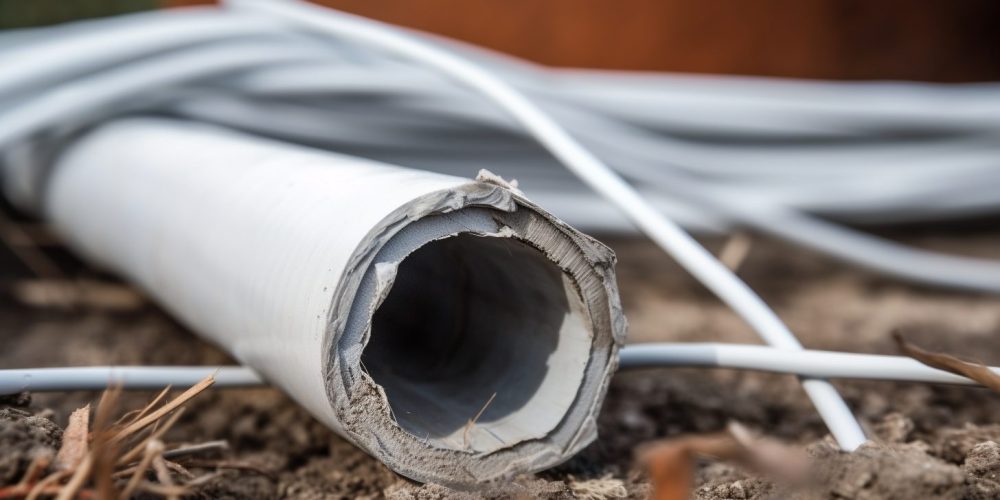When selecting the appropriate size of conduit for a 6/3 wire, it's important to consider various factors, including the type of conduit, the number of individual conductors, and the insulation thickness. By making the correct choice, you'll ensure the safety and efficiency of your electrical system.
In order to establish the appropriate conduit size for your 6/3 wire, begin by examining the following:
- Wire's cross-sectional area
- Conduit material
- Conduit length
- Conduit width
For example, a 1-inch schedule 40 PVC may serve as the minimum conduit size for 6/3 electrical wire, although this could differ based on the specific conduit material used.
Keep in mind the National Electrical Code (NEC) specifications when sizing conduit for cables. The maximum fill for one wire is 53%, for two wires it's 31%, and for three wires or more, it's 40% of the conduit's total available space.
Evaluating all these factors will help you choose the right conduit size for your 6/3 wire installation.
Understanding Conduit Requirements for 6/3 Wire
Using a conduit for your 6/3 wire is essential to protect the wire from physical damage, protect it in a wet location, and other external elements.
It will also help you route cables efficiently and adhere to safety standards. The conduit size depends on the wire's cross-sectional area, material, and the conduit's dimensions.
So, a 6/3 wire can squeeze into a ¾-inch conduit, right?
But how many cables you can fit in there really depends on what kind of conduit you're using.
Like, a ¾-inch PVC Sch 40 conduit can hold 21 wires that are 14AWG and 15 wires that are 12AWG. On the other hand, a ¾-inch PVC Sch 80 conduit can fit 17 wires that are 14AWG and 12 wires that are 12AWG.
For 6/3 wire, it is recommended to use at least a 1-inch schedule 40 PVC conduit, but this may vary based on the conduit material. Some common conduit materials include PVC, galvanized steel, and aluminum.
Each material has distinct characteristics that affect the conduit body durability, protection level, and ease of installation. It's crucial to select the right type of conduit based on your specific requirements and project constraints.

Different Types Of Conduit
When choosing a conduit size for your 6/3 wire, it is essential to consider the type of conduit that suits your needs whether it be a rigid or flexible metal conduit. In this section, we will discuss the three common types of conduit: PVC conduit, rigid conduit, and EMT conduit.
PVC Conduit
PVC conduit is a popular choice because it is affordable, lightweight, and corrosion-resistant. A 6/3 wire can fit comfortably in a ¾-inch PVC conduit; however, a ¾-inch PVC Sch 40 conduit can accommodate up to 15 12AWG wires, while an ¾-inch PVC Sch 80 conduit can hold up to 12 12AWG wires.
For larger wire capacities, a 2-inch PVC conduit can accommodate approximately 26 6/3 wires.
Rigid Metal Conduit
Rigid conduit is made of galvanized steel or aluminum and provides excellent mechanical protection for your wiring. This conduit type is suitable for heavy-duty applications and installations exposed to harsh environments.
Calculating the appropriate conduit size for your 6/3 wire requires considering your wire count, the overall fill percentage, and the conduit's inner diameter. Be sure to consult conduit sizing charts or an electrician to determine the best size for your specific project.
EMT Conduit
Electrical Metallic Tubing (EMT) conduit is made from thin-walled steel or aluminum and is a popular choice for its lightweight, ease of installation, and low cost.
When determining an appropriate conduit size for your 6/3 wire, remember that a smaller conduit may increase the difficulty of pulling the wire through it. As with the other conduit types, refer to conduit sizing charts or consult an electrician to select the optimal size for your installation.
When selecting the right conduit size for your 6/3 wire, always consider your specific project needs, applicable electrical code requirements, and the available space within the conduit.
Choosing the appropriate conduit type and size will ensure a safe and efficient electrical installation.
Best Conduit for 6/3 Wire
Choosing the right conduit size for your 6/3 wire is essential for safe and efficient electrical installations.
To determine the best conduit for your specific needs, it's important to consider factors such as the wire's cross-sectional area, conduit material, and the quantity of wires being used.
One suitable conduit size for a single 6/3 wire is a 1" schedule 40 PVC1. However, conduit material and size may vary depending on your specific requirements.
PVC conduits offer specific benefits, such as their ability to retain heat, shielding your wires from external temperature fluctuations. If your project requires routing over 26 6/3 wires, PVC conduits with diameters up to 4 inches could be an appropriate choice.
When selecting the best conduit for 6/3 wire, you must follow the National Electrical Code (NEC) specifications, which dictate the maximum fill percentages based on the number of wires in the conduit3:
- One wire: maximum fill is 53% of the conduit's internal space
- Two wires: maximum fill is 31%
- Three wires or more: maximum fill is 40%
To sum up, the best conduit size for 6/3 wire depends on the specific requirements of your project, such as the number of wires, location, conduit material, and adherence to NEC specifications.
Taking these factors into account will help you make an informed decision and ensure the safety and efficiency of your electrical wiring project.
Tips To Determine Conduit Size
When determining the appropriate conduit size for your 6/3 wire, it's essential to consider several factors. Follow these tips to make the right choice for your project:
1. First, assess the number of conductors that will be placed inside the conduit. This crucial aspect can impact the size of the conduit required. For instance, if you have three conductors with THHN insulation, a 1/2" conduit would typically be sufficient.
2. Check the insulation thickness of your wires. Different insulation materials can affect the overall size of the wire, which in turn influences the size of the conduit necessary to house it.
3. Consider the type of conduit you plan to use. Different materials and conduit types can further impact the size required for accommodating your 6/3 wire. In general, a 1" schedule 40 PVC is recommended as a starting point for conduit sizing, but the specific conduit size may vary with the material you choose.
4. Research and consult the National Electrical Code (NEC) guidelines for conduit sizing. Adhering to these established standards will ensure that your wiring project remains compliant with safety regulations.
5. Utilize conduit sizing calculators available online to help estimate the appropriate size for your 6/3 wire. These calculators can help you quickly determine the best conduit size based on your specific project requirements.
By taking these factors into account, you can confidently select the right conduit size for your 6/3 wire, ensuring a safe and efficient installation.
Factors Affecting Conduit Size
Numerous elements influence the appropriate conduit size for 6/3 wire. It is crucial to take these aspects into account while deciding on the correct conduit size for your particular project.
One key factor is the number of conductors that will be placed inside the conduit. The more conductors you have, the larger the conduit needs to be to accommodate them. It's important to observe the National Electric Code (NEC) fill requirements regarding the maximum amount of space conduits can occupy:
- One wire: maximum fill is 53% of the space inside a conduit
- Two wires: maximum fill is 31%
- Three wires or more: maximum fill is 40% of the total available space
Another significant factor is the insulation thickness of the wires. For example, if you have 6/3 wires with THHN insulation, you may require a smaller conduit size than if the wires have thicker THWN insulation.
The type of conduit also affects its size. Different materials, such as PVC or metal, have different internal diameters and may need different sizes to accommodate 6/3 wires. A 1" schedule 40 PVC conduit may be suitable for 6/3 wiring, but this can vary depending on the specific conduit material.
Final Thoughts
When determining the right conduit size for your 6/3 wire, it's crucial to take into account the number of conductors, insulation thickness, and the type of conduit you're using. Don't forget to adhere to NEC regulations to ensure a safe and efficient installation.
Here at Bates electric, we take the stress out of any project as our team of electricinas are professional and alays follows local electrical codes. Give us a call for a FREE estimate.
Frequently Asked Questions
What size conduit should I use for 6 gauge wire?
For 6/3 wire, a 1" schedule 40 PVC conduit is generally recommended, but it may vary depending on the conduit material and specific project requirements. It's essential to consult the National Electric Code (NEC) for specific guidelines and to ensure compliance with local regulations.
Contact us for a free estimate for your next project if you want to ensure you are up to local codes.
Can you run 6/3 wire without a conduit?
It depends on the installation environment and local electrical codes. In some cases, 6/3 wire can be run without conduit, however, using conduit can offer extra protection for the wire and ensure compliance with electrical codes.
How can I determine the capacity of a specific conduit size for holding 6/3 wires?
The number of 6/3 wires that can fit in a conduit depends on the conduit's size and material. Refer to this conduit fill calculator here to find specific information about conduit fill capacity based on the National Electric Code (NEC) guidelines.
Can I use Romex (NM-B) wire in conduit?
While it is possible to use Romex (NM-B) wire in conduit, it's essential to keep in mind local electrical codes and other factors that can affect the project. If you plan to use 6/3 Romex wire in a conduit, ensure proper installation by referring to the NEC guidelines or consulting a professional electrician.



